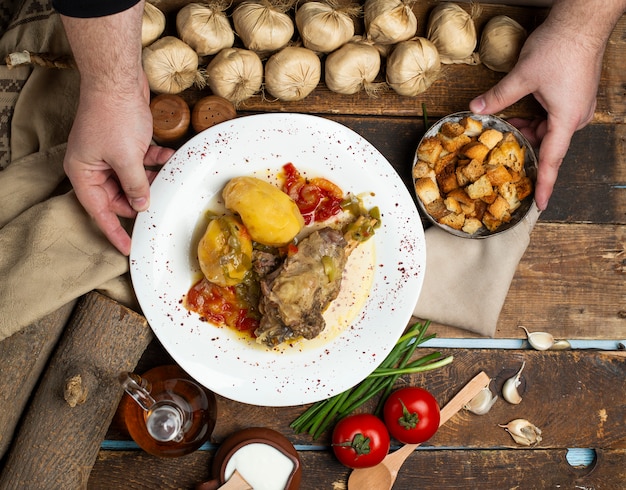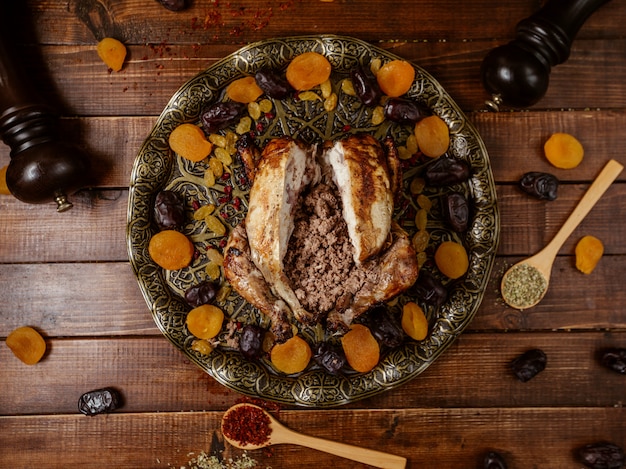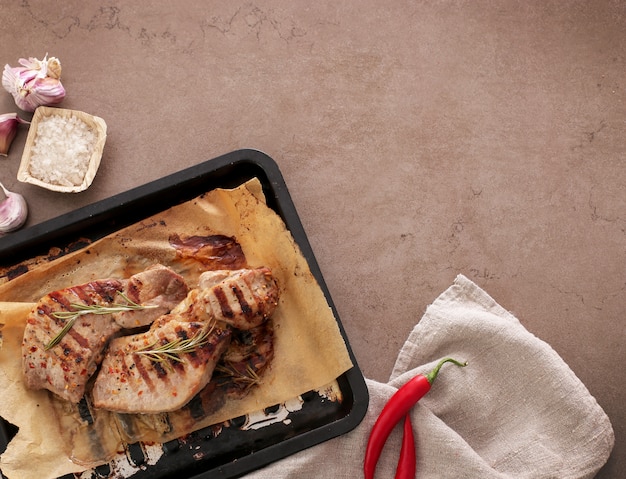Let's be honest, sometimes the simplest things can be the most perplexing in the kitchen. Turkey tenderloin is one of those culinary enigmas. These little guys, often tucked away next to the turkey breasts, promise a quick and easy meal. But, they can also be a bit of a culinary gamble, turning dry and tough if you're not careful.
Fear not, fellow food enthusiasts! I've been there, wrestled with the dry turkey tenderloin, and emerged victorious (with a few burnt offerings along the way, of course!). Through trial and error, I've learned a thing or two about cooking these little beauties. This guide is your secret weapon to consistently delicious, juicy turkey tenderloin, no matter your skill level.
(Part 1) Choosing the Right Tenderloin: Setting Yourself Up for Success

You wouldn't start building a house without the right foundation, would you? The same goes for cooking the perfect turkey tenderloin. Choosing a good one is the first step towards a delicious result.
1.1. The Freshness Factor: Sniff, Look, and Feel
First things first, give it a good sniff. A turkey tenderloin that's fresh should have a clean, almost neutral scent. Anything funky or strong is a sign it's past its prime. Next, check the colour. A healthy tenderloin will be a bright, white colour, almost like a pristine piece of paper. If it's got a greyish hue, it's been sitting around a bit too long. Finally, give it a gentle squeeze. You want it to feel firm, not soft or mushy. A bit of give is okay, but if it feels floppy, it's likely lost some of its moisture.
1.2. Size and Shape: Finding the Perfect Fit
When it comes to size, consider your needs. Are you cooking for one, two, or a family feast? For a solo or couples' meal, a smaller tenderloin will be perfect. But if you're feeding a crowd, go for a larger one. Remember, bigger tenderloins take a bit longer to cook.
Shape-wise, look for a uniform, even shape with no strange lumps or bumps. These irregularities can signal a less than ideal quality. Think of it this way, you want a piece that's going to cook evenly, and that's easier to do when it's got a consistent shape.
(Part 2) The Art of Seasoning: Adding Layers of Flavor

A well-seasoned turkey tenderloin is a symphony of tastes, and it all starts with the right seasonings. The good news is, you don't need to be a culinary wizard to create a delicious masterpiece.
2.1. The Classics: Salt and Pepper
You can't go wrong with a good old sprinkle of salt and pepper. These two humble seasonings work wonders in highlighting the natural flavor of the turkey. The key is to be light-handed. You want to enhance the flavor, not overwhelm it. A light dusting will do the trick.
2.2. Herbs and Spices: A Burst of Flavor
Want to add a little more oomph to your seasoning? Herbs and spices are your best friends! Paprika adds a subtle warmth, garlic powder brings a pungent aroma, and a pinch of cayenne pepper delivers a delightful kick. Fresh herbs like rosemary, thyme, and sage also pair beautifully with turkey.
2.3. Marinade Magic: Unlocking a World of Flavor
Ready to take your seasoning to the next level? Marination is the way to go. A simple marinade of olive oil, lemon juice, and herbs can work wonders. But, if you're feeling adventurous, experiment with different flavor profiles. Soy sauce, honey, and balsamic vinegar can add a touch of sweetness, savory depth, or tanginess.
Remember, moderation is key. Don't marinate the tenderloin for too long, otherwise it can become overly salty and tender. A couple of hours in the fridge is usually enough.
(Part 3) Cooking Methods: Unlocking the Culinary Secrets

Alright, let's get to the heart of the matter: the cooking! There are a few tried-and-true methods for cooking turkey tenderloin. Each has its own advantages and nuances to consider.
3.1. The Pan-Seared Method: Crispy Outside, Juicy Inside
This is my personal go-to method for achieving a juicy, flavorful turkey tenderloin. It's fast, easy, and delivers that irresistible crispy sear.
3.1.1. Searing Perfection: Creating the Golden Crust
First, get your pan smoking hot. We're talking serious heat here. Add a generous amount of oil, and carefully place the tenderloin in the pan. Don't crowd the pan, give it some space to breathe. Now, let's get that golden sear! Cook for a couple of minutes per side, making sure not to move it around too much. This will allow the tenderloin to develop a delicious, crispy crust.
3.1.2. Finishing Touches: Evenly Cooked, Juicy Delights
Once the tenderloin is seared on all sides, transfer it to a preheated oven. This will ensure it cooks evenly throughout. The oven temperature and cooking time will depend on the size of the tenderloin, but you're looking at about 15-20 minutes at 375°F (190°C). Remember, the key is to avoid overcooking. Use a meat thermometer to check the internal temperature. The tenderloin is done when it reaches 165°F (74°C).
3.2. The Oven-Roasted Method: Effortless and Flavorful
For a hands-off approach, oven roasting is your friend. It's also a great option if you're cooking for a larger group.
3.2.1. Roast it Right: Evenly Cooked Goodness
Preheat your oven to 375°F (190°C). Line a baking sheet with parchment paper for easy cleanup. Season the tenderloin generously, then place it on the prepared baking sheet. Pop it in the oven and let it roast for about 20-25 minutes, depending on the size.
3.2.2. Doneness Check: Making Sure It's Cooked Through
Don't forget to check the doneness with a meat thermometer. The tenderloin is done when it reaches an internal temperature of 165°F (74°C).
3.3. The Grill Method: Smoky Flavors and Outdoor Delights
Love the smoky flavor of grilling? This method is perfect for those warm summer evenings. Just remember, turkey tenderloin can go from juicy to dry quickly, so keep a close eye on it.
3.3.1. Grilling Basics: From Raw to Perfectly Cooked
Preheat your grill to medium-high heat. Season the tenderloin generously and place it on the grill. Close the lid and let it cook for about 10-15 minutes, depending on the thickness. Flip it halfway through to ensure even cooking.
3.3.2. Check for Doneness: No Guesswork, No Overcooked Turkey
Again, a meat thermometer is your best friend. The tenderloin is done when it reaches an internal temperature of 165°F (74°C).
(Part 4) Mastering the Perfect Doneness: A Juicy, Tender Turkey Tenderloin
Here's the thing: the goal is to achieve a tenderloin that's juicy and tender, not dry and tough. That's where understanding doneness comes in. There are a few ways to check, but let's be real, the meat thermometer is your best bet.
4.1. The Meat Thermometer: Your Ultimate Guide to Doneness
Let's face it, the meat thermometer is your trusty sidekick in the kitchen. It's the most accurate way to check if your tenderloin is cooked through. The ideal internal temperature is 165°F (74°C).
4.2. The Touch Test: A Bit More Subjective
You can also try the touch test, but it's not as reliable as a meat thermometer. If the tenderloin feels firm to the touch, it's probably done. But, don't rely on this method alone, it's a bit of a gamble.
4.3. The Colour Test: Not the Most Reliable Indicator
The colour test can also be misleading, especially with a smaller cut like a tenderloin. While a cooked tenderloin should be white throughout, if you see any pink areas, it needs more time in the heat. However, colour alone isn't a foolproof measure.
(Part 5) Resting is Key: Patience is a Virtue in the Kitchen
You've cooked it to perfection, but don't rush to cut it open right away! Resting the tenderloin is crucial. It gives the juices a chance to redistribute throughout the meat, resulting in a more succulent and tender piece.
5.1. The Resting Ritual: Allowing the Juices to Redistribute
Once the tenderloin is cooked, transfer it to a cutting board and cover it loosely with tin foil. Let it rest for about 10 minutes before carving. During this time, the juices will redistribute, making the meat more tender and flavorful.
(Part 6) Slicing and Serving: Showcasing Your Culinary Masterpiece
The time has come! After a well-deserved rest, it's time to slice and serve your culinary masterpiece.
6.1. Slicing Techniques: Tender Bites and a Beautiful Presentation
Start by slicing the tenderloin against the grain. This makes it easier to chew and creates more tender bites. Cut the tenderloin into ?-inch slices.
6.2. Serving Suggestions: Elevating the Dining Experience
Turkey tenderloin is incredibly versatile. Serve it with roasted vegetables, mashed potatoes, a simple salad, or a creamy sauce. Let your creativity shine!
(Part 7) Recipe Inspiration: Unleashing Your Inner Chef
Now that you've got the fundamentals down, let's get creative. Here are a few delicious turkey tenderloin recipes that you can try at home.
7.1. The Classic Turkey Tenderloin with Roasted Vegetables
This is a simple yet satisfying dish that's perfect for a weeknight meal.
Ingredients
- 1 pound turkey tenderloin
- 1 tablespoon olive oil
- 1 teaspoon salt
- 1/2 teaspoon black pepper
- 1 cup chopped vegetables (such as broccoli, carrots, and onions)
- 1/4 cup chicken broth
Instructions
- Preheat oven to 400°F (200°C).
- Season the tenderloin with salt and pepper.
- Heat the olive oil in a large skillet over medium-high heat.
- Sear the tenderloin on all sides.
- Transfer the tenderloin to a baking sheet.
- Add the vegetables to the skillet and cook for 5 minutes, or until slightly softened.
- Pour the chicken broth into the skillet and bring to a simmer.
- Transfer the vegetables to the baking sheet with the tenderloin.
- Roast for 15-20 minutes, or until the tenderloin reaches an internal temperature of 165°F (74°C).
- Let the tenderloin rest for 10 minutes before slicing and serving.
7.2. Honey Garlic Glazed Turkey Tenderloin
This recipe is a bit more indulgent, but it's oh-so-delicious! The honey garlic glaze adds a sweet and savory flavour that's simply irresistible.
Ingredients
- 1 pound turkey tenderloin
- 1 tablespoon olive oil
- 1 teaspoon salt
- 1/2 teaspoon black pepper
- 1/4 cup honey
- 2 tablespoons soy sauce
- 1 tablespoon minced garlic
Instructions
- Preheat oven to 375°F (190°C).
- In a small bowl, whisk together the honey, soy sauce, and garlic.
- Season the tenderloin with salt and pepper.
- Heat the olive oil in a large skillet over medium-high heat.
- Sear the tenderloin on all sides.
- Transfer the tenderloin to a baking sheet.
- Pour the honey garlic glaze over the tenderloin.
- Roast for 15-20 minutes, or until the tenderloin reaches an internal temperature of 165°F (74°C).
- Let the tenderloin rest for 10 minutes before slicing and serving.
7.3. Lemon Herb Turkey Tenderloin with roasted asparagus
This is a light and refreshing recipe that's perfect for a summer meal.
Ingredients
- 1 pound turkey tenderloin
- 1 tablespoon olive oil
- 1 teaspoon salt
- 1/2 teaspoon black pepper
- 1 tablespoon lemon juice
- 1 tablespoon chopped fresh herbs (such as parsley, thyme, and rosemary)
- 1 pound asparagus, trimmed
Instructions
- Preheat oven to 400°F (200°C).
- In a small bowl, whisk together the olive oil, lemon juice, salt, pepper, and herbs.
- Place the tenderloin in a baking dish and pour the marinade over it.
- Toss the asparagus with 1 tablespoon of olive oil, salt, and pepper.
- Spread the asparagus around the tenderloin in the baking dish.
- Roast for 15-20 minutes, or until the tenderloin reaches an internal temperature of 165°F (74°C) and the asparagus is tender-crisp.
- Let the tenderloin rest for 10 minutes before slicing and serving.
(Part 8) Beyond the Basics: Exploring New culinary adventures
Turkey tenderloin is a blank canvas for culinary creativity. Think outside the box and try these unique dishes:
8.1. Turkey Tenderloin Stir-Fry: A Fast and Flavorful Feast
Craving a quick and easy meal bursting with flavor? This stir-fry is a winner!
Cut the turkey tenderloin into bite-sized pieces. Stir-fry them with your favorite vegetables and sauce. For an extra touch, sprinkle with sesame seeds for a delightful crunch.
8.2. Turkey Tenderloin Skewers: A Fun and Festive Presentation
Looking for a fun and festive dish? Thread turkey tenderloin chunks onto skewers with colorful vegetables like bell peppers and onions. Grill or bake them until the turkey is cooked through.
8.3. Turkey Tenderloin Tacos: A Flavorful Twist on Tradition
Want to put a new spin on traditional tacos? Shred some cooked turkey tenderloin and use it as a filling. Top with your favorite toppings, like salsa, sour cream, and cheese.
(Part 9) FAQs: Answers to Your Burning Questions
Now, let's tackle those lingering questions about cooking turkey tenderloin.
9.1. How long can I store a turkey tenderloin in the fridge?
You can store a turkey tenderloin in the fridge for up to 3-4 days. Make sure it's tightly wrapped in plastic wrap or foil.
9.2. Can I freeze a turkey tenderloin?
Yes, you can freeze a turkey tenderloin for up to 2-3 months. Wrap it tightly in plastic wrap and then place it in a freezer-safe bag. Thaw it in the fridge overnight before cooking.
9.3. What happens if I overcook a turkey tenderloin?
If you overcook a turkey tenderloin, it will become dry and tough. So, make sure you cook it to the right temperature and don't overcook it.
9.4. What are some good side dishes for turkey tenderloin?
Turkey tenderloin goes well with a variety of side dishes. Some popular options include roasted vegetables, mashed potatoes, rice, pasta, and salads.
9.5. Can I reheat turkey tenderloin?
Yes, you can reheat turkey tenderloin. You can do this in the oven, microwave, or skillet. Just make sure it's heated through to 165°F (74°C).
(Part 10) The Last Word: A Farewell to the Tenderloin
There you have it, your ultimate guide to cooking turkey tenderloin. It's a small but mighty piece of meat that deserves a place in your culinary repertoire. Next time you're at the supermarket, grab a tenderloin or two, and give these tips and recipes a try. You won't be disappointed.
Happy cooking!
Everyone is watching

How to Cook Frozen Lobster Tails Perfectly: A Step-by-Step Guide
RecipesLobster. Just the word conjures up images of lavish meals, special occasions, and a taste of luxury. But let's...

Pigs in a Blanket Cooking Time: How Long to Bake for Perfect Results
RecipesAh, pigs in a blanket. Just the name conjures up images of those delightful little parcels of crispy pastry en...

Pork Fillet Cooking Time: How Long to Cook It Perfectly
RecipesPork fillet, or tenderloin as it's sometimes called, is a real favourite in our house. It's so versatile, and...

The Ultimate Guide to Tender, Juicy Pulled Pork
RecipesRight, let's talk pulled pork. It's one of those dishes that just screams "comfort food," doesn't it? I mean...

The Ultimate Guide to Cooking Delicious Frankfurters
RecipesLet's face it, we all love a good frankfurter. It's a classic, simple, and always satisfying. But let's be rea...
